Fermented Beets with Cumin and Basil
This post may contain affiliate links. Please read my disclosure policy.
What is Fermentation?
Bubbles, bacteria, probiotics, enzymes & minerals ……
Pickles, sauerkraut, kombucha, kefir, kvass………
Natural fermentation is quite a fascinating process, relying on just salt and water to make things literally come alive, turning your favorite fruits and vegetables into even healthier and delicious bites. One of the ways it’s different than what we think of as “pickling” is that hot brine or acid (like vinegar) is never used because that kills all of the powerhouse nutrients, and halts any type of good bacteria (like those in yogurt) from growing.
Fermentation extends the life of foods, as beneficial bacteria consume the natural sugars and produce lactic and acetic acid for preservation. And they keep your tummy happy, producing vitamins, that help to populate the gut with microbes and boost the immune system.
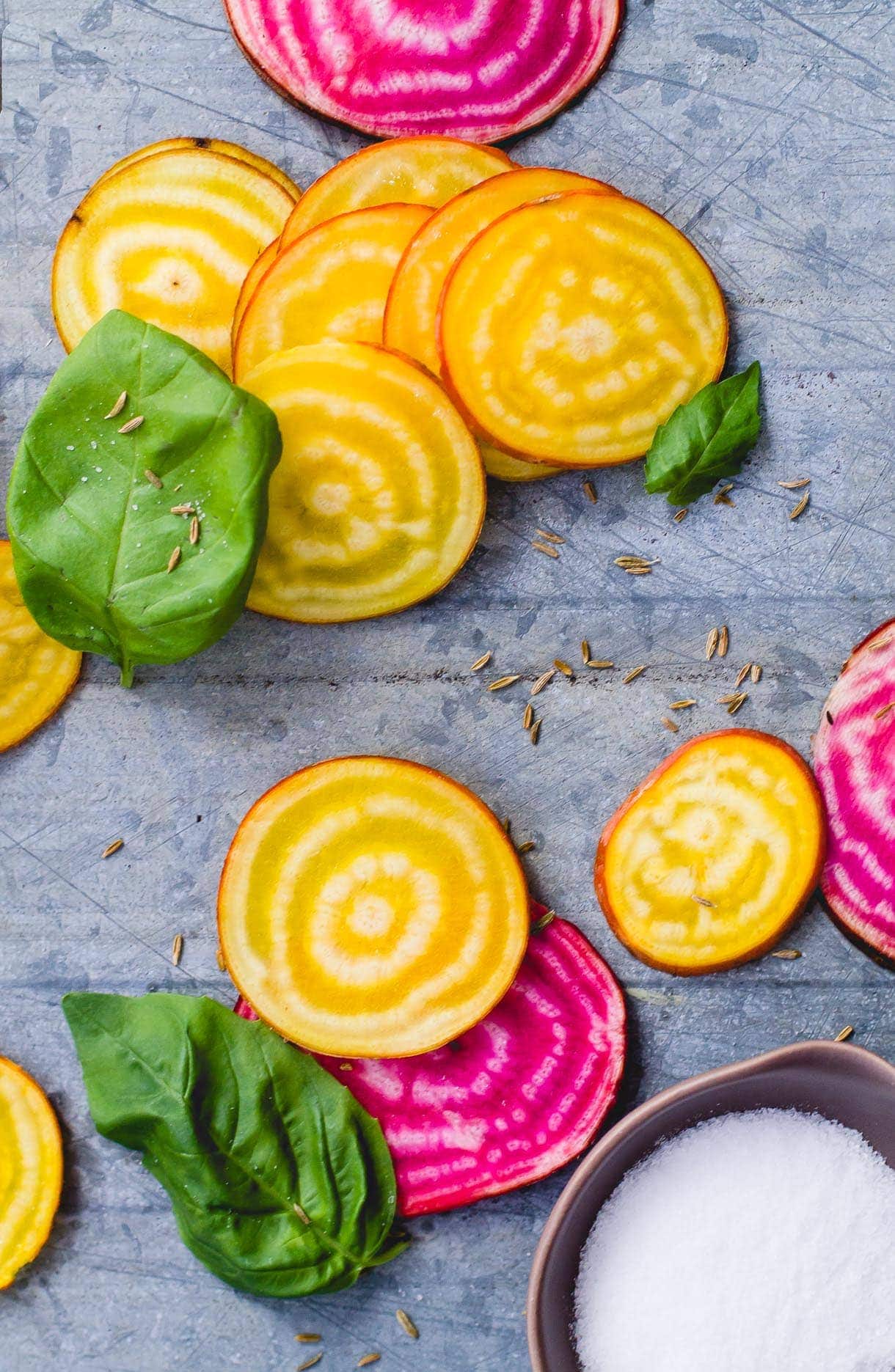
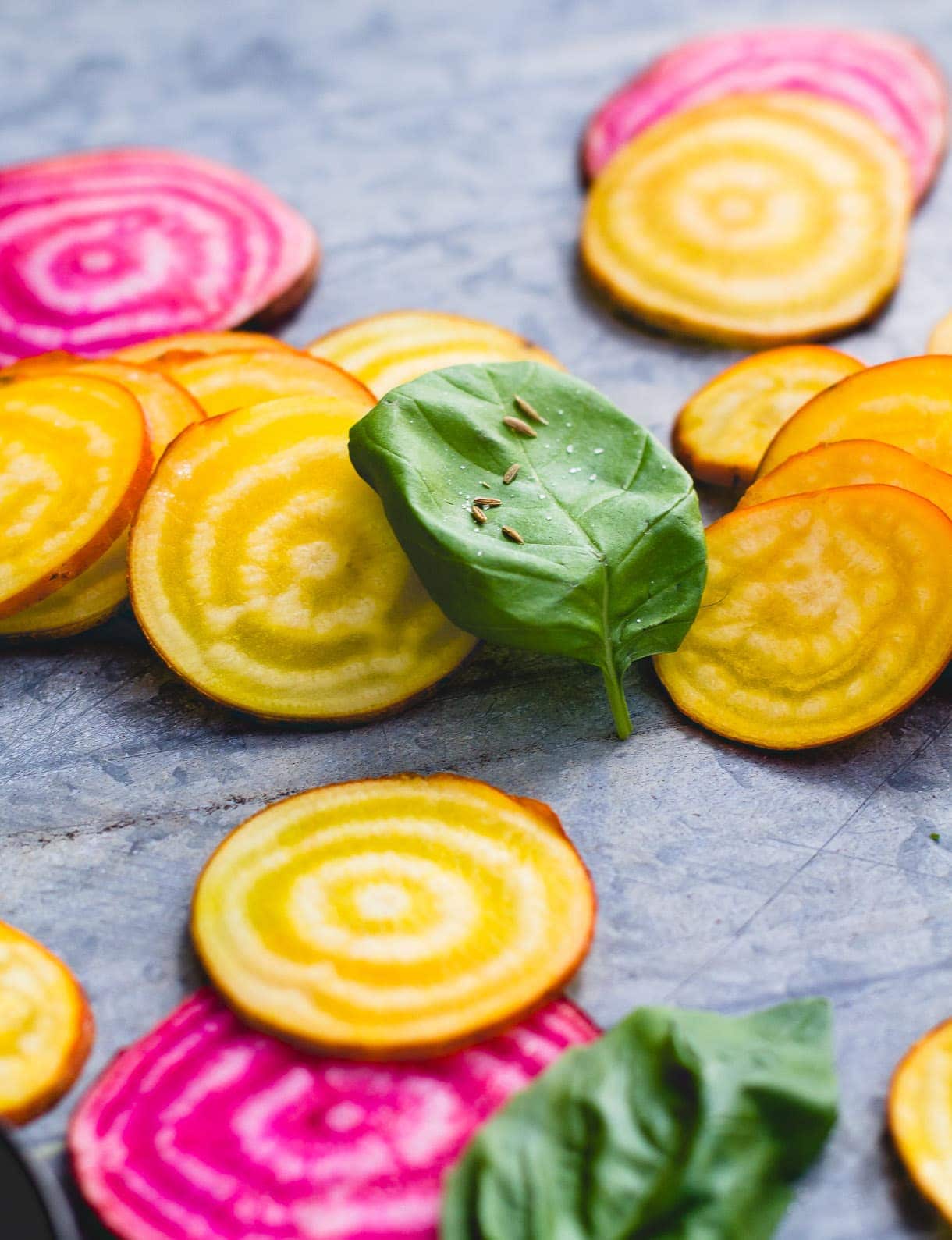
I tried fermenting years ago, starting with kimchi, and then kombucha, figuring it was just like a science experiment and relying on the resources I could find. Thankfully I stumbled upon Amanda’s inspiring and helpful blog, Phickle, basically an encyclopedia on everything you ever wanted to know about these crazy microbial adventures. I felt so comfortable following her recipes and tutorials, seriously demystifying the world of fermentation for me.
And now she’s written a beautiful book, Ferment Your Vegetables! I got lost in it the days after it landed on my doorstep, between the stunning photos and her practical advice on how to get your own little kitchen bubbling with jars of condiments, kraut, pickles, and even different appetizers (like fermented winter squash hummus!) you can make with the results.
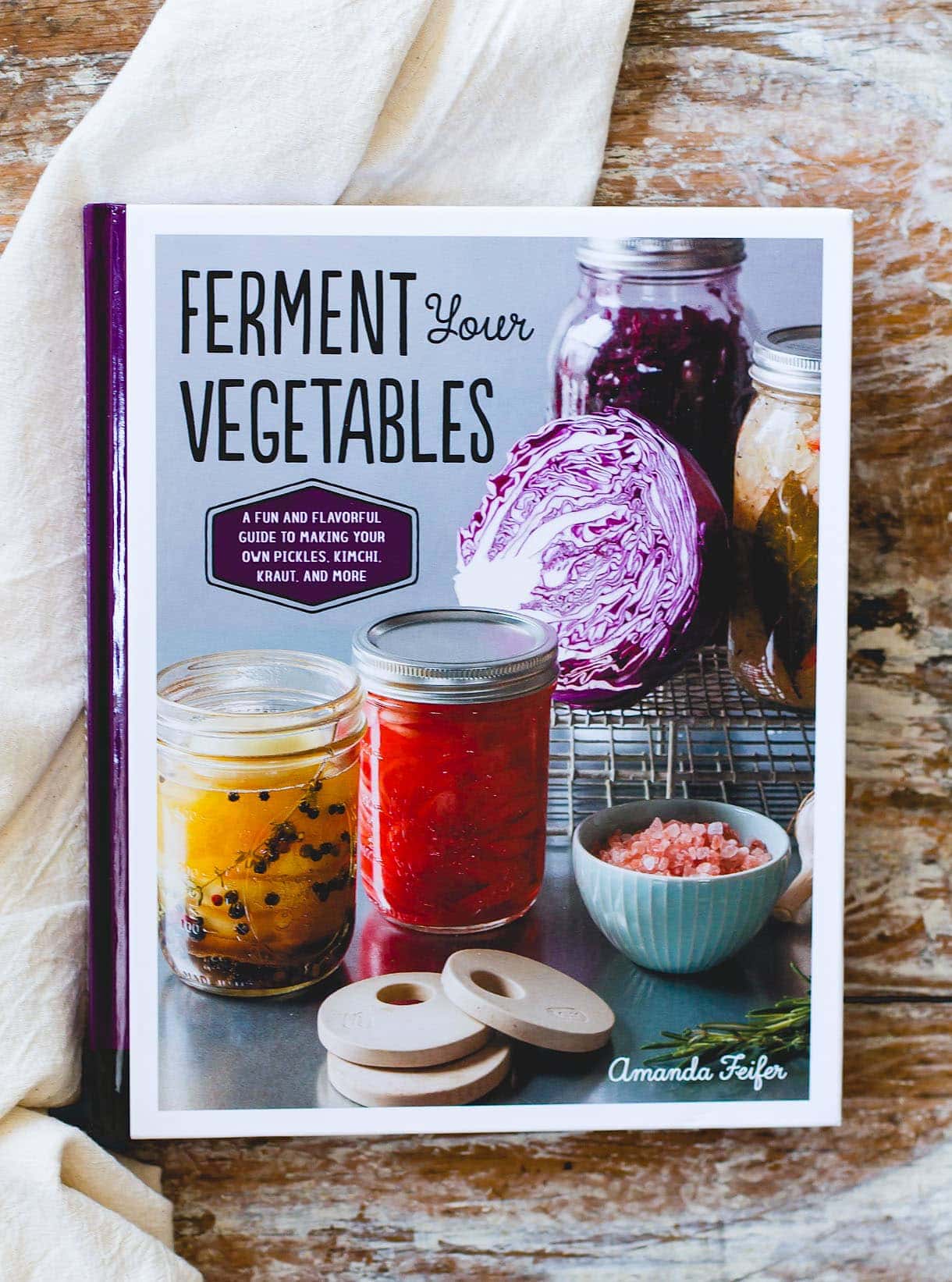
I couldn’t help but make these Fermented Beets with Cumin and Basil first, imagining how beautiful they would shine in the jars, and a flavor combination that just spoke to me. I was dying to try this tangy, earthy, version of one of my favorite vegetables.
They turned out incredible. Delicately spiced and a bit sour like a good pickle should be. These colorful babes made me fall in love with beets all over again.
With natural fermentation, the earthiness of the beets turns sweeter and brighter – a true testament of how food can naturally transform into something so different. Another great example is how the fermentation of wild yeast in a sourdough starter naturally leavens sourdough bread.
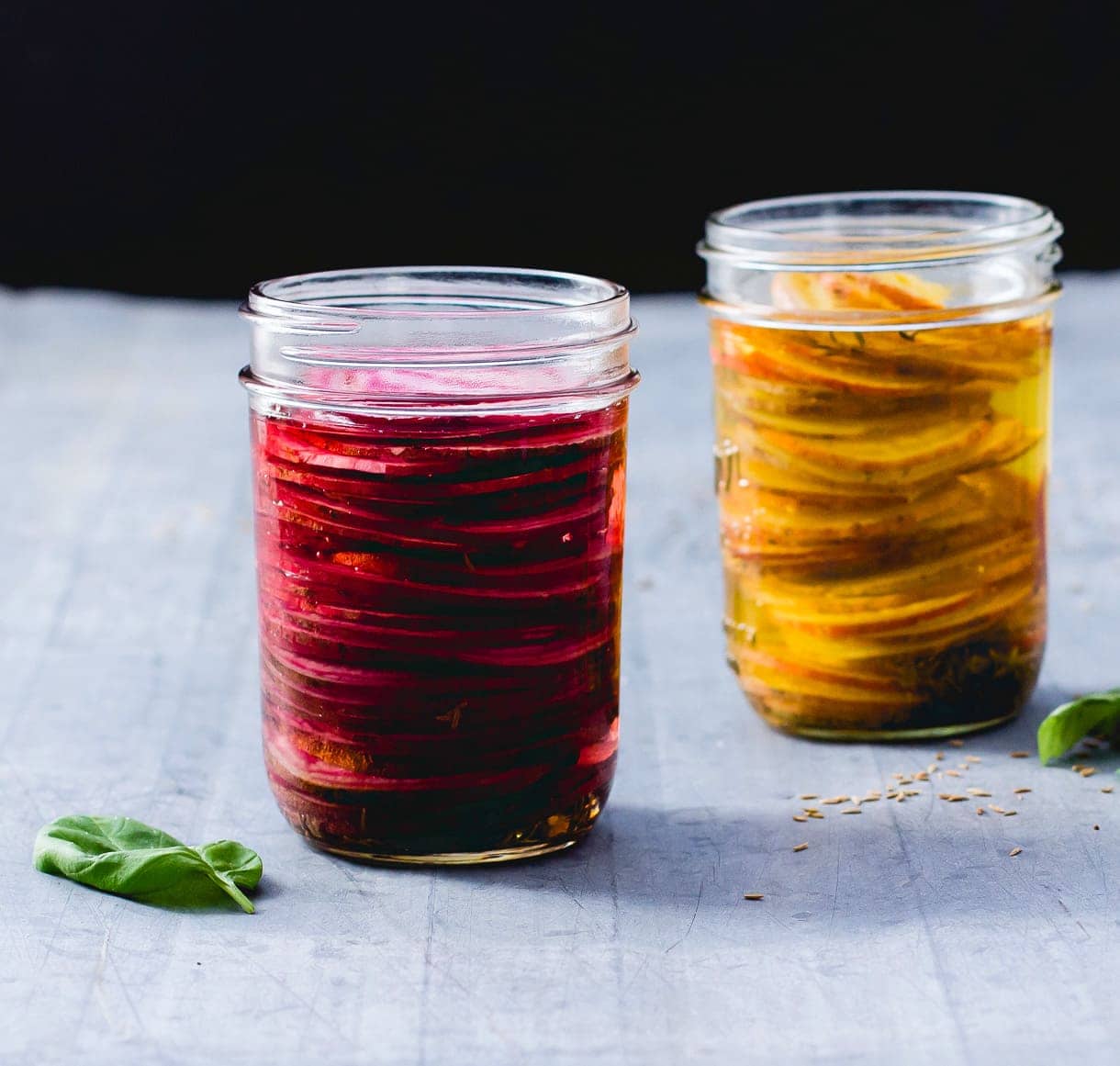
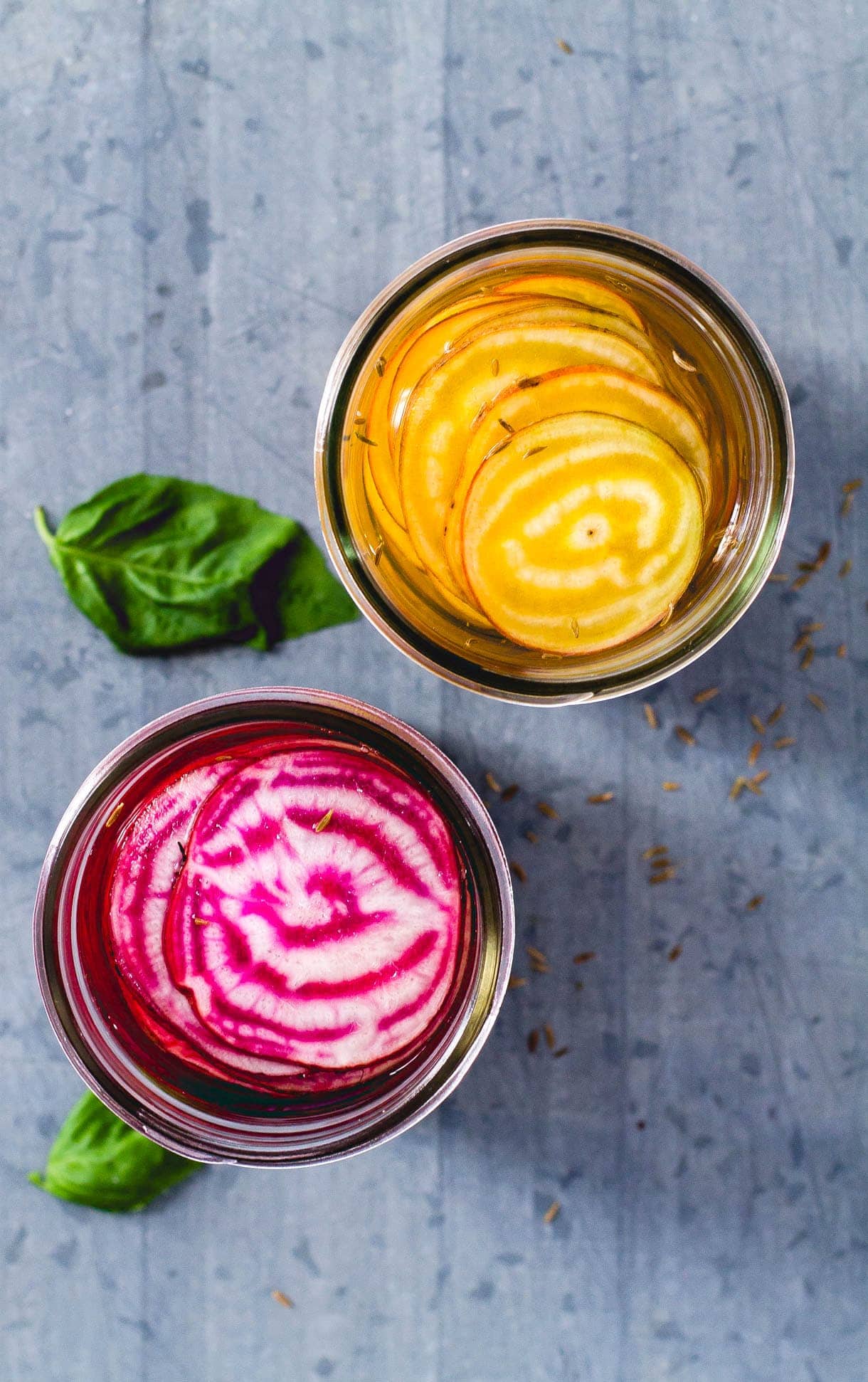
Tips for Fermenting Vegetables
- Make sure you to use washed, very clean glass jars.
- Let your ferments (beets in this case) sit for 7-10 days in a warm spot, around 65-78 degrees F. That is the perfect environment for the bacteria and acid to growing..
- You’ll want to make sure the brine sits above the vegetables, using something that submerges them. I used another jar pushed inside the other. And then you MUST cover the jar with a cloth so that bacteria in the air can’t get inside. I learned that the hard way, with one batch that got slimy.
- Check on them periodically to make sure if the jar has overflowed, you wipe up the spills. If they’re bubbling – that’s a good thing! And if the water is turning a little cloudy, that’s also good.
- Taste every 3 days or so to see how they taste. When they’re bright, sour, and salty, they’re done. The length of time it takes to get to this stage can differ depending on how warm your environment is.
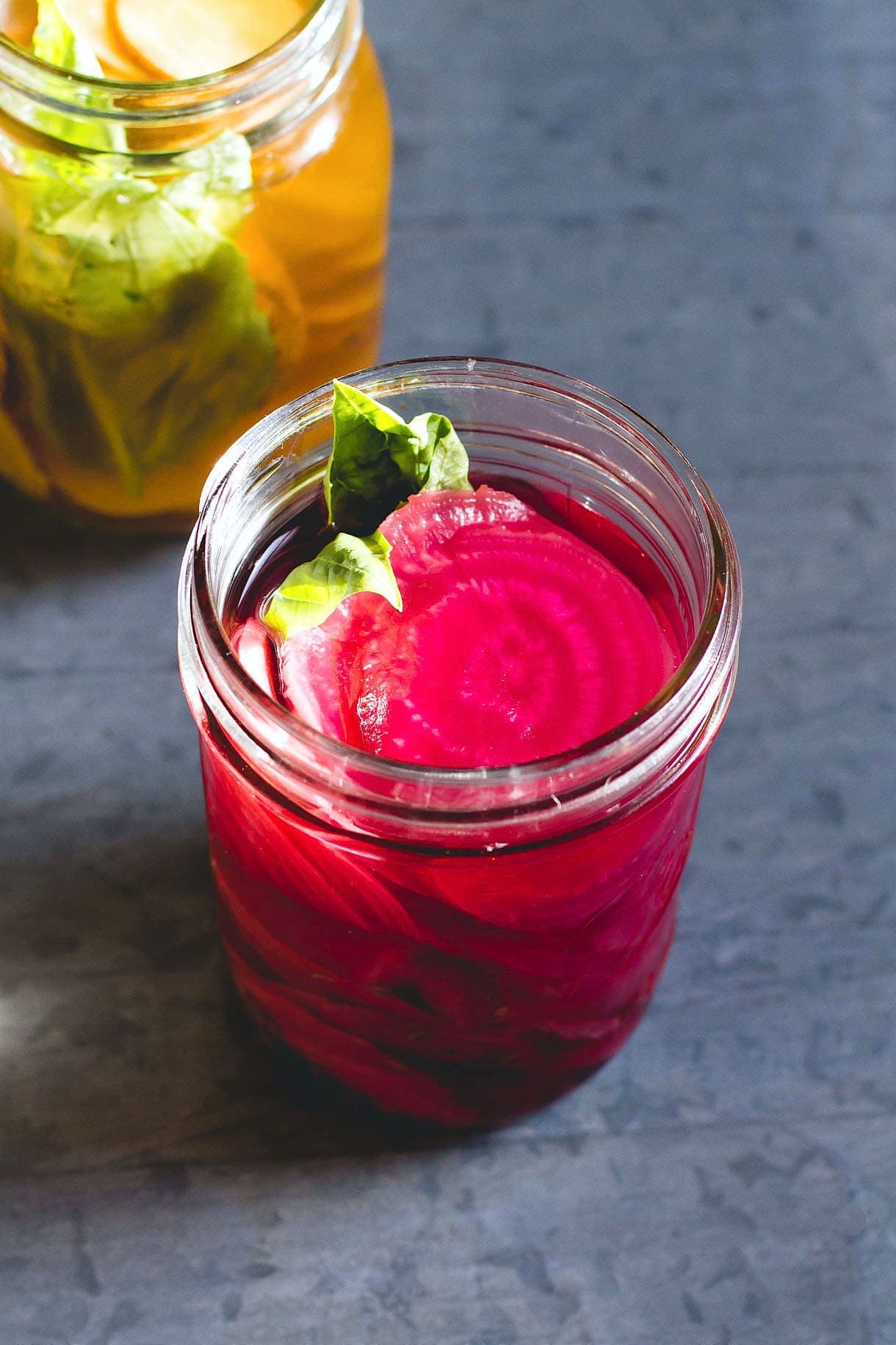
Not only are they great as snack, but they make a beautiful pickle plate, with goat cheese and a heavy drizzle of olive oil.
I’ve also been eating them on salads, diced and stirred into scrambled eggs, and as a topping for juicy cuban pork bowls.
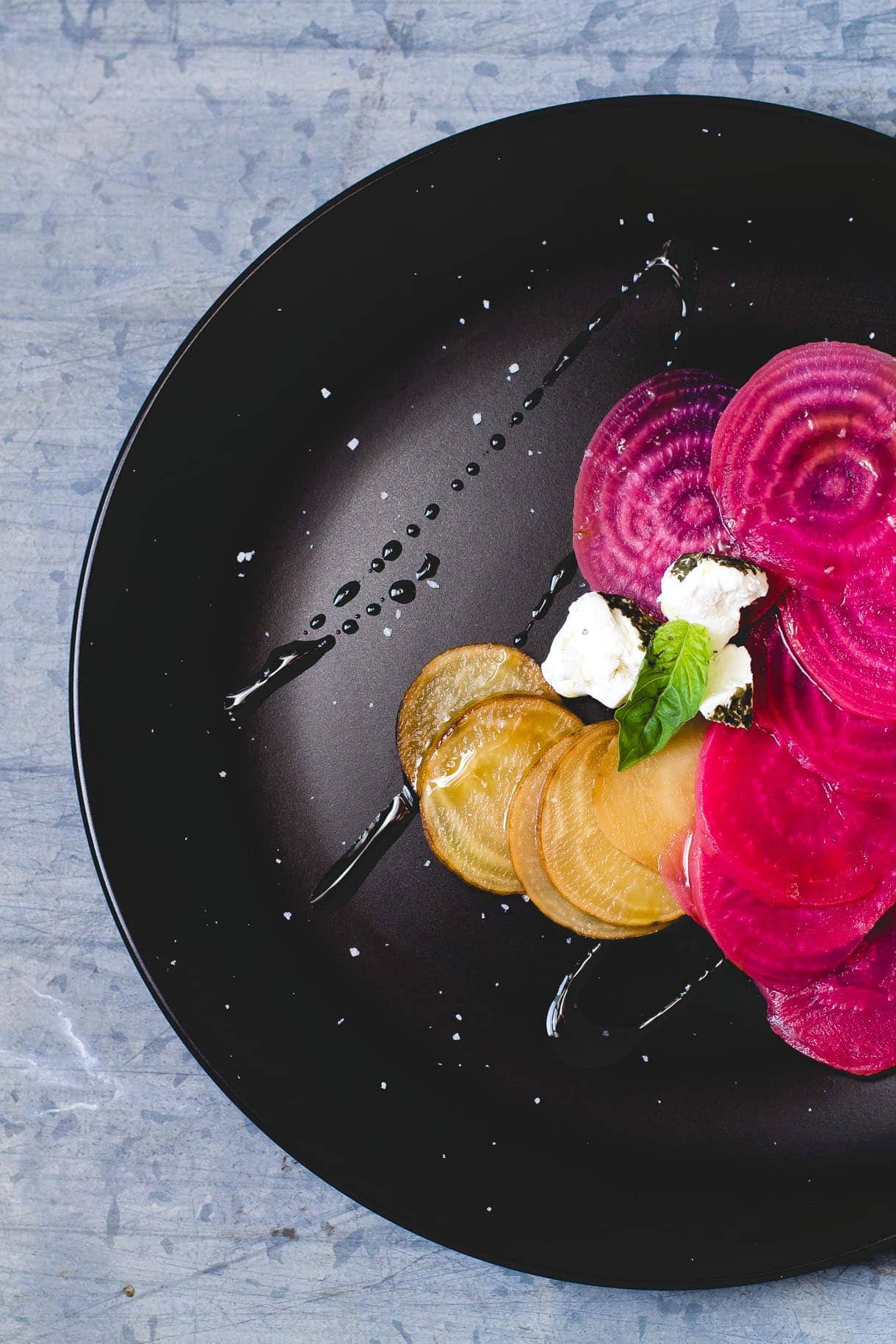
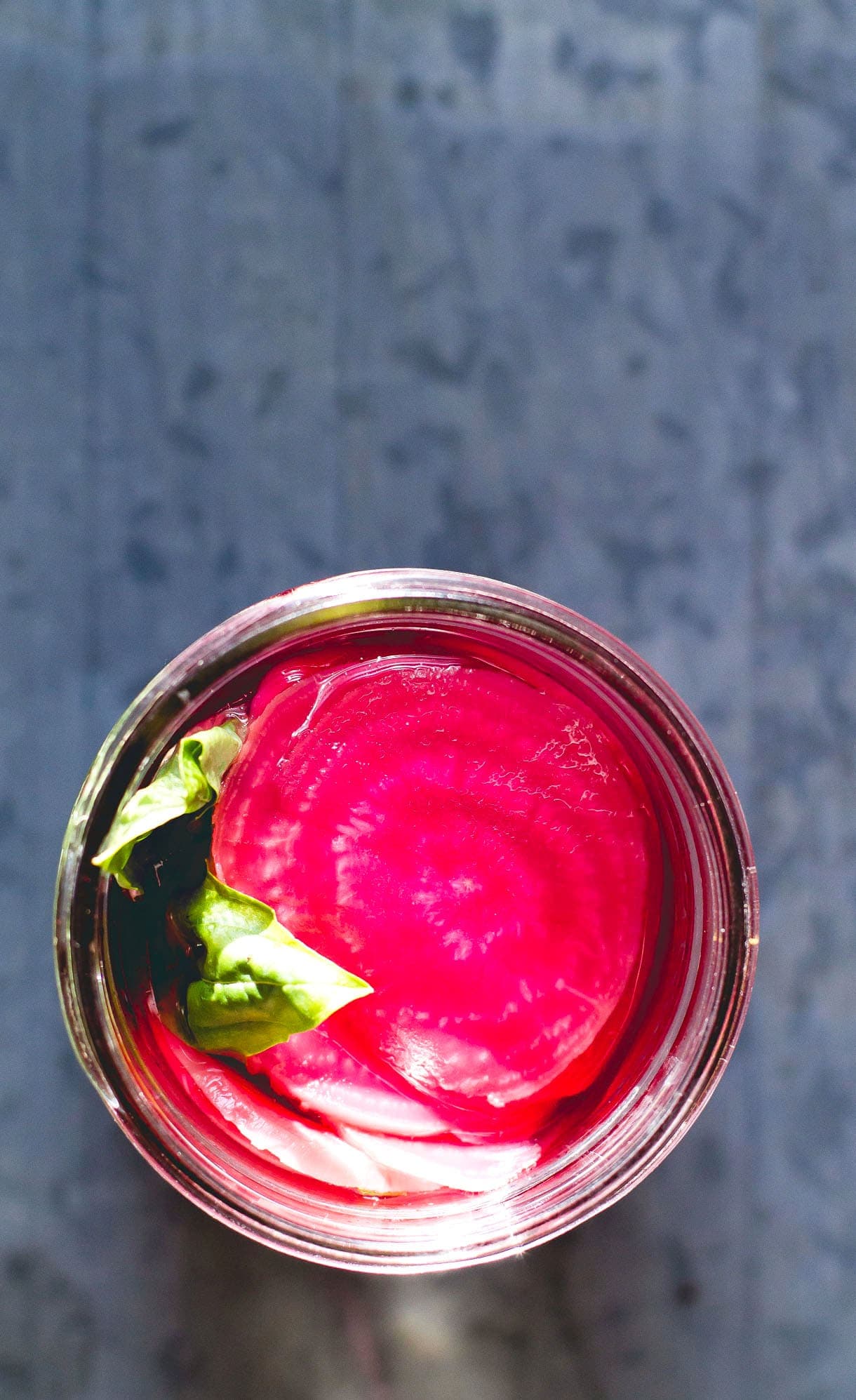
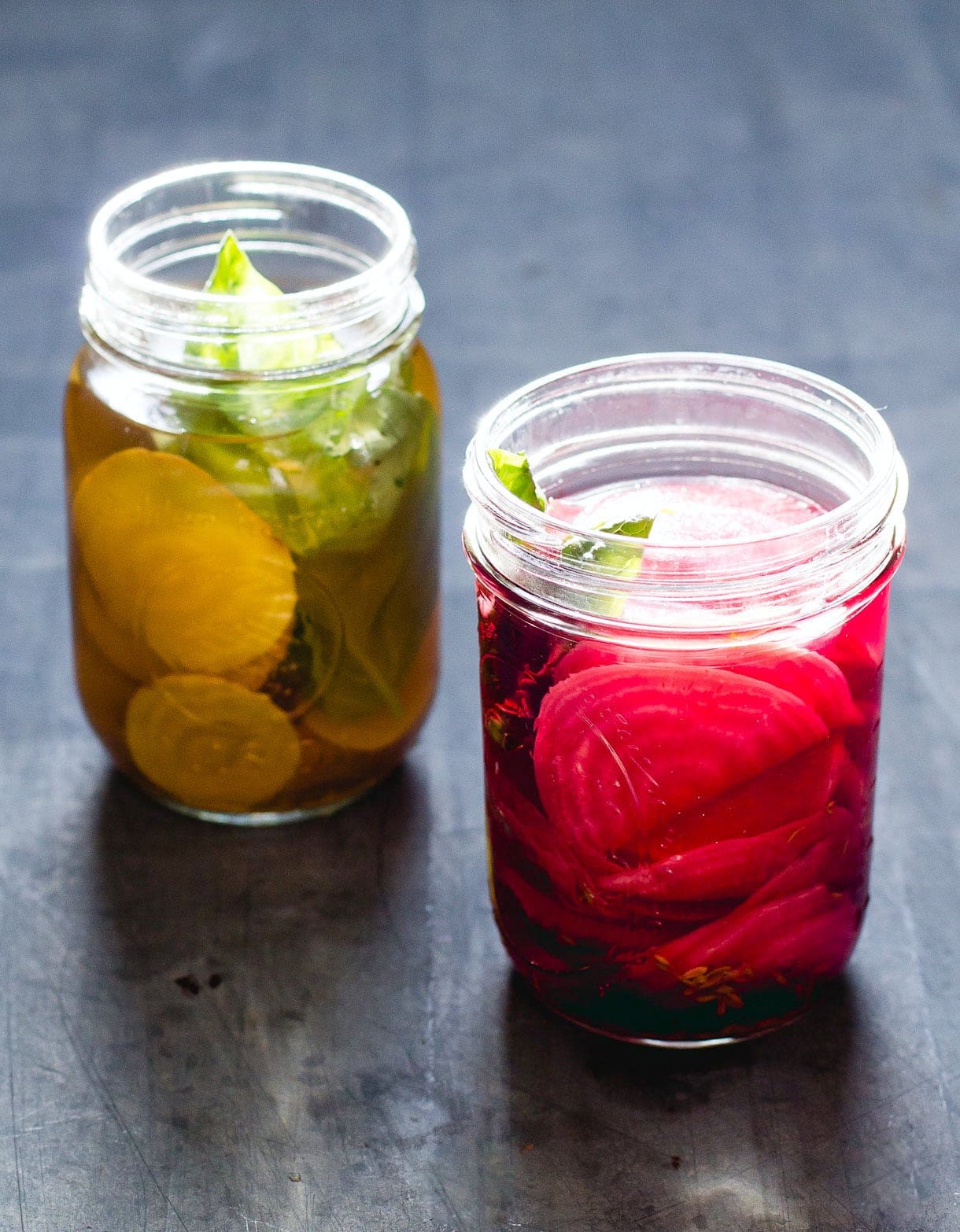
SCALE:
Ingredients
- 4 or 5 small beets (1 pound) — I used chiogga beets, the pink & white ones, and gold beets.
- 1 1/2 teaspoons (3.5 grams) cumin seeds
- 1 tablespoon (18 grams) kosher salt
- 2 cups filtered water (not tap water)
- 1/4 cup whole basil leaves
Instructions
- Slices the beets into 1/4 inch slices.
- Put the cumin seeds in the bottom of two pint jars and stack the beets on top.
- Mix the salt into the water until dissolved, then pour brine into jars until beets are just covered. (If you need to add a little more filtered water, that is okay.)
- Submerge your veggies with a vessel, like another jar that fits inside, and cover these.
- Place jars on small plate and allow to ferment at room temperature (65-78 degrees F) for 1 to 2 weeks.
- Once you’re happy with the flavor and acidity, remove the weights and pack basil into each jar. Put lid on and refrigerate. After two days remove the basil (or it will spoil). Enjoy! These will last up to 3 months in the refrigerator.
Notes
Did you make this?
tag @heartbeetkitchen on instagram and hashtag it #heartbeetkitchen



Daria Messino
July 8, 2020
How to you clean the dirt off of the beets without removing the good microbes?
Muskratmom
February 1, 2019
Does the shape of the pieces matter? I grow mostly lutz beets and slices are too big. Is this the basisod brscht?
amandapaa
February 1, 2019
any shape will work! as long as you use a jar they fit and the liquid covers them completely.
Darci Reeves
July 3, 2018
would it be ok to use powdered cumin instead of seeds?
amandapaa
July 3, 2018
If you don’t have cumin seeds, I would just leave it out.
Hawk
September 30, 2017
Is this like canning where they will last for a long period of time. Years
amandapaa
September 30, 2017
Hello! This is not a traditional canning recipe. Once they have fully fermented on on your shelf, they’ll last 3-4 months in the refrigerator.
Randi
January 20, 2017
Do you cover the jar with a lid, or just a cloth while fermenting? (Newbie and just not sure)
amandapaa
January 20, 2017
Hi Randi!
Yes, use a cloth, not a lid. A lid will prevent fermentation from occurring. I left helpful hints about the process in the paragraphs right above the recipe.
Kallie Miller
January 16, 2017
Any reason you could not use a quart jar?
amandapaa
January 16, 2017
you certainly could! just be sure that the beets stay submerged.
Kallie Miller
January 16, 2017
Thank you for your reply. I am going to make them tonight with excitement.
Amy
November 29, 2016
I would LOVE to try this as I love both red beets and basil but I would be terrified that I would give my family food poisoning! If it is fermented, does it contain alcohol?
amandapaa
November 29, 2016
Hi Amy! There is no alcohol in this, nor are there any byproducts created when the beets ferment. You can ready more about natural fermentation here: http://www.thekitchn.com/recipe-lactofermented-mixed-pickles-recipes-from-the-kitchn-194011
Angela
July 10, 2016
Are the beets raw? If so how did you remove the skins? Or did you?
amandapaa
July 10, 2016
Hello! The beets are raw and you leave the skins on.
Eden Passante
February 25, 2016
This is so cool! Need to try this!
amandapaa
February 25, 2016
thanks Eden! they’re such a colorful addition to tacos or salads. and yay for good probiotics!
Patricia @ Grab a Plate
February 5, 2016
So gorgeous! Your photos are amazing! I can imagine how wonderful these taste. I also had no idea about the pickling vs. fermenting process. Thanks for the great info and recipe!
amandapaa
February 6, 2016
thanks Patricia! yes, give fermentation a try. it really is a cool process. and i love the pickles!
Alice Seuffert
February 5, 2016
So gorgeous! I love golden beets and what a fun new way to try them!
Katie | Healthy Seasonal Recipes
February 5, 2016
Love these good-for-you beet pickles. My mind is blown too about the nuts. Have to check it out.
Christine
February 3, 2016
I recently saw this book and thought it looked beautiful! I’ve only ever made sauerkraut, kvass and pickled radish, and I still get just a little nervous whenever I have a fermentation project on the go. It really is just like a science experiment! I can’t get over how pretty these are Amanda! I am really excited to try these :)
aida mollenkamp
February 3, 2016
Um, these are the most gorgeous preserved beets I ever did see!
amandapaa
February 4, 2016
thank you Aida! the colors were just so vibrant in the sunlight.
Mel @ The Refreshanista
February 2, 2016
I’m just starting to get into fermenting. I made my own kimchi, and this recipe looks like the perfect next step! These beets sound wonderfully flavourful and look gorgeous too!
amandapaa
February 3, 2016
awesome work on the kimchi! i think you’d love these pickles. so tasty on tacos!
Linda | The Baker Who Kerns
February 2, 2016
I just love all the beautiful colors that beets have. I can’t believe there are so many cool and different types of beets out there, like those red and white striped ones! I’ve been wanted to ferment and can things for a while but it is one of those things that intimidates me in the kitchen. I really want to make my own sauerkraut! That would be my first thing to do! Maybe I’ll go to the bookstore and sit down and read this book and get some tips. I’m always that weird one on the flour with mountains of books around me.
amandapaa
February 2, 2016
same here Linda! i recently discovered white beets too. i was intimidated by fermenting as well, and they are definitely things i question while they are bubbling away, but you get the hang of it. the book seriously took away my anxiety, super resourceful. and so many unique recipes! xo
Emily | Gather & Dine
February 2, 2016
Love this post, Amanda! For the longest time mold was also the intimidation factor for me, but finally I got brave and started with kimchee too. And it turned out to be so much easier than I had expected! It’s also such a money saver when you compare to all of those fancy ferments at Whole Foods. Your beets are just gorgeous and I’m so inspired to try this! Goodness, I have SO many cookbooks, but I’m very tempted to get this one as well. :)
Liz @ Floating Kitchen
February 2, 2016
The scientist in me just LOVE kitchen projects like this. Fun, nerdy and totally delicious all at the same time. I love these photos – they are like a breath of fresh air in the middle of winter. I think I’m going to need to pick up this book!
Tessa | Salted Plains
February 2, 2016
Ok, the colors in these photos are crazy pretty! I have always been so timid to try fermenting anything for fear I would do something wrong. It sounds like the book simplifies the process and makes it easy to check yourself. I need to do this! xo.
Lauren Gaskill | Making Life Sweet
February 1, 2016
Wow, Amanda. These beets are absolutely stunning. With some carrots and hummus to go with, I see this being my new favorite snack for sure! :)
Faith (An Edible Mosaic)
February 1, 2016
I honestly don’t think I’ve ever seen prettier pickles! You have such a way of seeing beauty everywhere, my friend. I love fermented things too, but I’ll admit, it’s been way too long since I made homemade pickles and apple cider vinegar! I need to get back into it; homemade beats the pants off anything store-bought! xoxo
amandapaa
February 1, 2016
Thank you Faith :) I couldn’t resist the beautiful light coming in on a winter day to capture their color! I am so intrigued by the apple cider vinegar thing. I need to try that. I know how good it is for you! xo
danielle // rooting the sun
January 31, 2016
yes amanda! these beets are so incredibly beautiful, employing such a great method of preservation. i love the image of other fermentation projects bubbling away in your kitchen (not to mention they sound amazing – fermented nuts and turnip slices?!). all of this excites me in grand ways. xo
Hannah | The Swirling Spoon
January 31, 2016
The most beautiful fermented vegies I ever did see! I think my trepidation around fermentation really hangs on the word “SCOBY”. Haha. I need to let it go so I can give this a try! And beautiful photography, too. x
amandapaa
February 1, 2016
right Hannah? i think of of the cartoon scooby doo, then food, then this giant slimy thing and i just don’t know how it makes something so delicious. lol. i’ve made it once at home, but i didn’t feed the scoby enough. off to try it again :)
Traci | Vanilla And Bean
January 31, 2016
I was completely sucked in by the colors of the glorious beet root and they are soooo delicious right now. A perfect time for fermenting or pickling. Now, I’ve pickled before and fermented kimchi… but never have I fermented beets! I gotta give this a go. What fun! I’ll check out Amanda’s site. Thank you for this my dear! Looking forward to seeing your sauerkraut! WOW!!